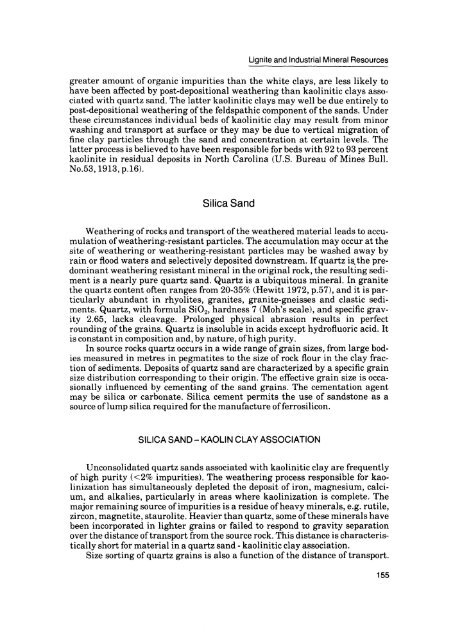Moose River Basin: geology and mineral potential - Geology Ontario
Moose River Basin: geology and mineral potential - Geology Ontario
Moose River Basin: geology and mineral potential - Geology Ontario
You also want an ePaper? Increase the reach of your titles
YUMPU automatically turns print PDFs into web optimized ePapers that Google loves.
Lignite <strong>and</strong> Industrial Mineral Resources<br />
greater amount of organic impurities than the white clays, are less likely to<br />
have been affected by post-depositional weathering than kaolinitic clays asso<br />
ciated with quartz s<strong>and</strong>. The latter kaolinitic clays may well be due entirely to<br />
post-depositional weathering of the feldspathic component of the s<strong>and</strong>s. Under<br />
these circumstances individual beds of kaolinitic clay may result from minor<br />
washing <strong>and</strong> transport at surface or they may be due to vertical migration of<br />
fine clay particles through the s<strong>and</strong> <strong>and</strong> concentration at certain levels. The<br />
latter process is believed to have been responsible for beds with 92 to 93 percent<br />
kaolinite in residual deposits in North Carolina (U.S. Bureau of Mines Bull.<br />
No.53,1913,p.l6).<br />
Silica S<strong>and</strong><br />
Weathering of rocks <strong>and</strong> transport of the weathered material leads to accu<br />
mulation of weathering-resistant particles. The accumulation may occur at the<br />
site of weathering or weathering-resistant particles may be washed away by<br />
rain or flood waters <strong>and</strong> selectively deposited downstream. If quartz is^the pre<br />
dominant weathering resistant <strong>mineral</strong> in the original rock, the resulting sedi<br />
ment is a nearly pure quartz s<strong>and</strong>. Quartz is a ubiquitous <strong>mineral</strong>. In granite<br />
the quartz content often ranges from 20-359fc (Hewitt 1972, p.57), <strong>and</strong> it is par<br />
ticularly abundant in rhyolites, granites, granite-gneisses <strong>and</strong> clastic sedi<br />
ments. Quartz, with formula SiO2 , hardness 7 (Moh's scale), <strong>and</strong> specific grav<br />
ity 2.65, lacks cleavage. Prolonged physical abrasion results in perfect<br />
rounding of the grains. Quartz is insoluble in acids except hydrofluoric acid. It<br />
is constant in composition <strong>and</strong>, by nature, of high purity.<br />
In source rocks quartz occurs in a wide range of grain sizes, from large bod<br />
ies measured in metres in pegmatites to the size of rock flour in the clay frac<br />
tion of sediments. Deposits of quartz s<strong>and</strong> are characterized by a specific grain<br />
size distribution corresponding to their origin. The effective grain size is occa<br />
sionally influenced by cementing of the s<strong>and</strong> grains. The cementation agent<br />
may be silica or carbonate. Silica cement permits the use of s<strong>and</strong>stone as a<br />
source of lump silica required for the manufacture of ferrosilicon.<br />
SILICA SAND - KAOLIN CLAY ASSOCIATION<br />
Unconsolidated quartz s<strong>and</strong>s associated with kaolinitic clay are frequently<br />
of high purity ^29c impurities). The weathering process responsible for kao<br />
linization has simultaneously depleted the deposit of iron, magnesium, calci<br />
um, <strong>and</strong> alkalies, particularly in areas where kaolinization is complete. The<br />
major remaining source of impurities is a residue of heavy <strong>mineral</strong>s, e.g. rutile,<br />
zircon, magnetite, staurolite. Heavier than quartz, some of these <strong>mineral</strong>s have<br />
been incorporated in lighter grains or failed to respond to gravity separation<br />
over the distance of transport from the source rock. This distance is characteris<br />
tically short for material in a quartz s<strong>and</strong> - kaolinitic clay association.<br />
Size sorting of quartz grains is also a function of the distance of transport.<br />
155

















